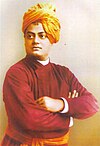| Revision as of 14:05, 10 September 2013 editWhisperToMe (talk | contribs)Autopatrolled, Extended confirmed users662,928 edits Add Bengali title indicated on India noticeboard← Previous edit | Revision as of 14:12, 10 September 2013 edit undoTitodutta (talk | contribs)Autopatrolled, Administrators156,709 edits rmv BEngali title, against WP:INDIA consensusNext edit → | ||
| Line 33: | Line 33: | ||
| Title of subsequent poem in series --> | Title of subsequent poem in series --> | ||
| }} | }} | ||
| '''''Nachuk Tahate Shyama''''', ( |
'''''Nachuk Tahate Shyama''''', (translated as ''"And Let Shyama Dance There"'' or ''"Let Shyama Dance There"''), is a ] poem written by Indian Hindu monk ].<ref name="Vivekananda 2004 p602">{{Harvnb|Vivekananda|2004|p=602}}</ref> The poem was originally published in two issues in ''Vivekodayam'' in 1904. The poem was later included in the second volume of ''The Complete Works of Swami Vivekananda''.<ref name="Vivekananda 1989 p103">{{Harvnb|Vivekananda|1989|p=103}}</ref> | ||
| == Lyrics == | == Lyrics == | ||
Revision as of 14:12, 10 September 2013
| Nachuk Tahate Shyama | |
|---|---|
| by Swami Vivekananda | |
 Hindu goddess Shyama, whom the poet worshiped in this poem Hindu goddess Shyama, whom the poet worshiped in this poem | |
| Country | India |
| Language | Bengali |
| Publisher | Vivekodayam |
| Publication date | 1904 |
Nachuk Tahate Shyama, (translated as "And Let Shyama Dance There" or "Let Shyama Dance There"), is a Bengali language poem written by Indian Hindu monk Swami Vivekananda. The poem was originally published in two issues in Vivekodayam in 1904. The poem was later included in the second volume of The Complete Works of Swami Vivekananda.
Lyrics
The first stanza of the poem in English and Bengali are given below. Read the full poem at Wikisource.
| English version | Bengali version |
|---|---|
|
Beaut'ous blossoms ravishing with perfume, |
ফুল্ল ফুল সৌরভে আকুল, মত্ত অলিকুল গুঞ্জরিছে আশেপাশে । |
Theme
Vivekananda dealt with the world of consciousness in this poem. According to Indian historian Ramesh Chandra Majumdar the poem included references to natural features, "the charm of sex", and "maddening wine of love". Swami Vivekananda made an English version of his poem, titled "'And Let Shyama Dance There". Ramesh Chandra Majumdar wrote that the English poem "gives a somewhat unique pen-picture of sweet and grim aspects of Nature alternated with telling effect which shows a literary artist's imageries at their best."
Influence
Ratna Ghosh, author of Netaji Subhas Chandra Bose and Indian Freedom Struggle: Subhas Chandra Bose : his ideas and vision, stated that the poem "instilled an attraction for the unknown into the mind of" Subhas Chandra Bose, and that he "very often recited the poem with such an unbounded impetuosity as if it seemed he got an image of his own ideal in it."
References
Citations
- Vivekananda 2004, p. 602
- Vivekananda 1989, p. 103
- Chakrabarti 1998, p. 164
- ^ Majumdar 1963, p. 553
- Ghosh2006, p. 12
Works cited
- Chakrabarti, Mohit (1998). Swami Vivekananda, Poetic Visionary. M.D. Publications Pvt. Ltd. pp. 164–. ISBN 978-81-7533-075-7. Retrieved 10 September 2013.
{{cite book}}: Invalid|ref=harv(help) - Majumdar, Ramesh Chandra (1963). Swami Vivekananda Centenary Memorial Volume. Swami Vivekananda Centenary. Retrieved 10 September 2013.
{{cite book}}: Invalid|ref=harv(help) - Ghosh, Ratna (2006). Netaji Subhas Chandra Bose and Indian Freedom Struggle: Subhas Chandra Bose : his ideas and vision. Deep & Deep. ISBN 978-81-7629-843-8. Retrieved 10 September 2013.
{{cite book}}: Invalid|ref=harv(help) - Vivekananda, Swami (2004). Prabuddha Bharata: Or Awakened India. Swami Smaranananda. Retrieved 10 September 2013.
{{cite book}}: Invalid|ref=harv(help) - Vivekananda, Swami (1989). Awakened India. Swami Smaranananda. Retrieved 10 September 2013.
{{cite book}}: Invalid|ref=harv(help)
